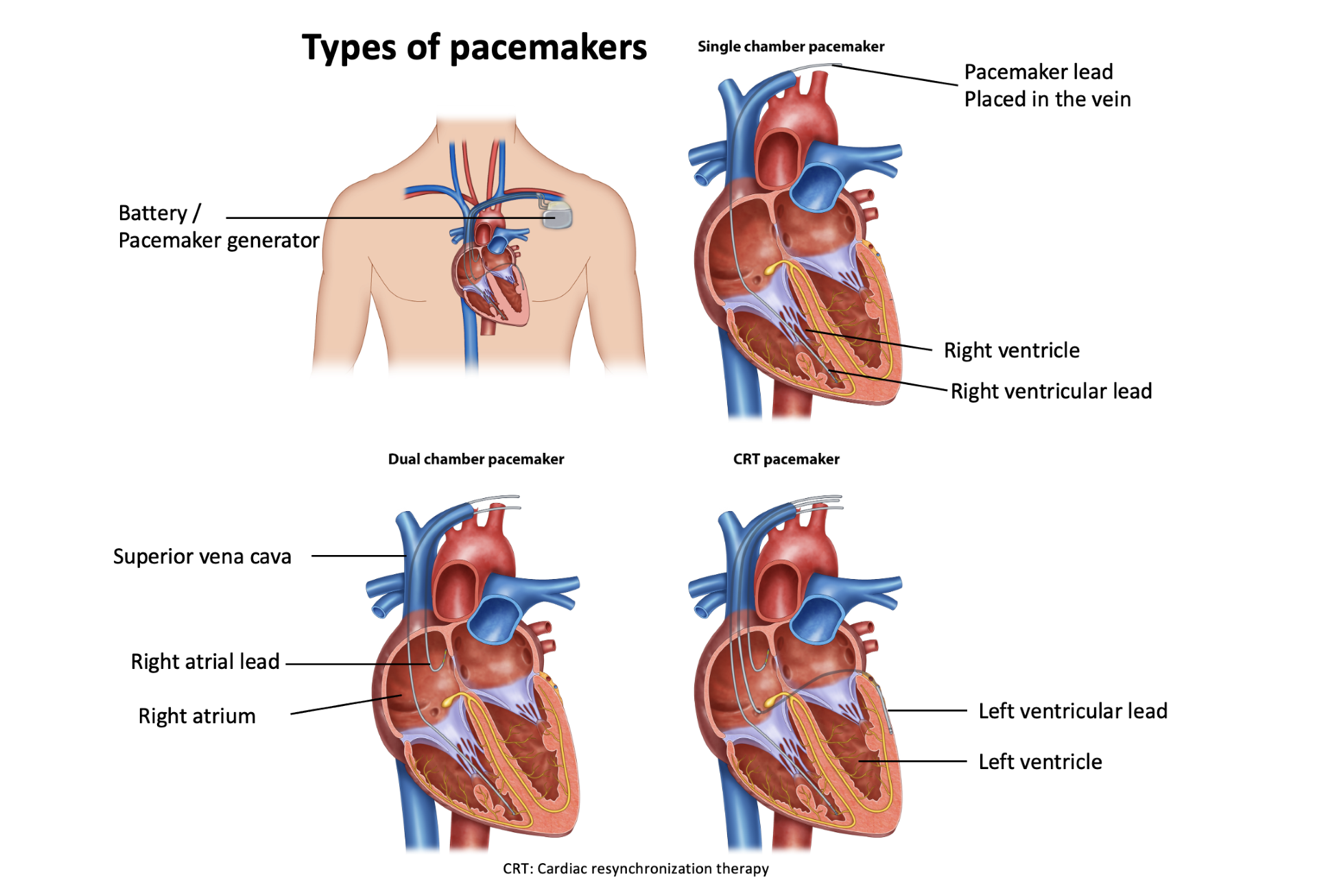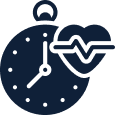Pacemaker Implant
A cardiac pacemaker is a small electronic device that is implanted under the skin, usually in the chest area, to stop the heart from going too slow and in selected cases, improve the heart’s efficiency. It consists of a generator (also the battery) and one or more leads (thin wires) that are threaded through veins and positioned in the heart. The pacemaker continuously monitors the electrical activity of the heart and delivers electrical impulses, or pacing signals, to stimulate the heart to beat at a normal rate.
The pacing signals are sent through the leads to specific chambers of the heart, such as the atria (upper chambers) or the ventricles (lower chambers), depending on the individual’s needs. This electrical stimulation helps maintain an appropriate heart rate, especially in cases where the natural electrical conduction system of the heart is not functioning properly or is too slow.
The pacemaker can be programmed by a healthcare professional to deliver different types and strengths of pacing signals based on the person’s specific condition. It can also record data about the heart’s electrical activity, which can be analysed during follow-up appointments to assess the device’s performance and the person’s heart function.
Cardiac pacemakers are commonly used to treat various heart rhythm disorders, such as bradycardia (a slow heart rate), heart block (a disruption in the electrical signals between the heart chambers), and certain types of arrhythmias. The pacemaker helps improve symptoms related to these conditions, such as fatigue, dizziness, and fainting, and can significantly enhance the individual’s quality of life.
Are there different types of pacemakers?
Yes, there a different type of pacemakers. In general pacemakers can have 1, 2 or 3 wires. Most common Is the two-wire system called a dual chamber pacemaker.

Pacemaker leads can be placed just at the surface of the heart or deep into the thick and muscular ventricular septum called deep septal or left bundle branch pacing or conduction system pacing.
Different companies manufacture these devices with their own unique offerings. Common pacemaker brands are Medtronic, St Jude Medical, Boston Scientific, Biotronik, Sorin to name a few.
What are the risks of having a pacemaker?
They include but are not limited to the following.
Common risks and complications (more than 5%) include:
- Bruising / bleeding at the pacemaker site
- Large collection of blood (Haematoma) – this can take several weeks to settle
- Pain at the pacemaker site
Uncommon risks and complications (1- 5%) include:
- The pacemaker / device lead(s) can move. The lead will need to be put back into place by repeating this procedure
- Bad bruising if you are taking blood thinning drugs such as Warfarin, Xarelto, Eliquis, Dabigatran Aspirin, Clopidogrel (Plavix or Iscover) or Dipyridamole (Persantin or Asasantin)
- Unexpected device failure. There is a risk of battery (generator) or lead failure. This is uncommon but means the battery or lead will need to be removed and a new one put in
- Infection of the pacemaker site. This will need treatment with antibiotics and/or removal of the pacemaker
Rare risks and complications (less than 1%) include:
- A punctured lung (pneumothorax). This may require a tube to be inserted into the chest to reinflate the lung
- Blood clot in the subclavian vein (Deep vein thrombosis)
- A hole is accidentally made in the heart or heart (perforation) – This will need surgery to repair
- Blood clot in the lung (pulmonary embolus)
- Heart attack
- A stroke. This can cause long term disability
- Death is possible due to the procedure or other heart problems
- Tricuspid regurgitation
- Infection of heart valve and other infections
What happens during the procedure?
Pacemaker insertion is very common and takes approximately 1 hour for a standard dual chamber device. Other special procedures such as CRT and deep septal pacing can take longer. Procedure is usually performed in the catheter laboratory or operating theatre. You will be lying on a narrow bed under the X-ray machine arm that can move in and out of position.
Pacemakers are generally performed under sedation. General anaesthesia may be considered in some cases and may require an arterial line to monitor your blood pressure. Antibiotics are usually given prior to the procedure.
The upper chest is usually shaved again if needed, cleaned with a special antiseptic wash and once dry, a long sterile drape is placed over the site. The drape covers you from head to toe. You will have someone to assist you if needed. Once you are comfortable, local anaesthetic is administered at the incision site which numbs the area. You’ll feel an initial sharp and burning or pricking sensation when the local anaesthetic is injected but it becomes numb in less than a minute. You may feel a pulling / pushing sensation during the operation which is normal.
A 5 to 8cm cut is made just below your collarbone. The tissue under the skin is carefully dissected and a space is created just above the chest muscle. Usually, a needle is advanced into the vein deeper in the chest under the clavicle. Special dye (Contrast) injection maybe required to identify the vein. The pacing leads are then guided into the vein and advanced into the correct chamber of your heart using X-ray. They are secured to the heart tissue either by a tiny screw at the end of the wire (Active lead) or soft hooks (Passive lead). The leads are secured to the underlying muscle with permanent sutures over a special cuff on the wire called suture sleeve.
The other end of the lead is connected to the pacemaker, which is placed in the small pocket created over the muscle. The wound is closed with absorbable sutures and a water-resistant dressing applied on top of the wound.
You’ll usually need to stay in hospital overnight and may have a chest Xray that night. A pacemaker check is performed the next morning. People can usually go home the next day if tests are all normal.
What happens after a pacemaker implant?
At the end of your procedure, a simple dressing is applied over the pacemaker site. You may have a larger dressing applying pressure at the site overnight. You’ll be watched closely in a recovery area, and depending on how you feel, you might need to rest in bed for a while. You will be admitted to the ward for observation overnight with rhythm monitoring. A chest X-ray may be performed in some cases. People are usually discharged the next day after a pacemaker check.
What happens after discharge?
Wound Care:
- The dressing on your wound should be left in place for two weeks. You may shower, as it is waterproof, but you cannot submerge in a bath or pool.
- Two weeks after the operation, please see your GP to have the dressing removed. Do not remove or change the dressing before this time.
- If the wound becomes red, hot, swollen, more painful or starts to drain fluid, see your local doctor immediately, or call the rooms on 9500-0296.
Special Issues:
- DRIVING: You may drive after two weeks. You can find out more about the driving restrictions from the Austroads website (https://austroads.com.au/drivers-and-vehicles/assessing-fitness-to-drive)
- MOVEMENT OF SHOULDER: Please minimise the use of the shoulder on the side of the operation for one month. Do not raise your arm to above shoulder height, do not use the arm to push out of a chair, and no heavy lifting for one month. This is to ensure that the flexible wires connecting the pacemaker to your heart do not move. After a month these will be firmly stuck in position by the body’s healing process.
- It is normal to take Paracetamol (Panadol) regularly for the first few days at home.
Other Special Issues: As outlined in the information booklet that you would receive from the pacemaker company, these relate to things such as mobile phone use, use of machinery and certain medical tests or procedures you may need in the future, some of which may either interfere with the pacemaker, or need the pacemaker to be adjusted beforehand.
The device / generator can sometimes move down slightly over time.
Airline Travel: You will be given a card with the details of your pacemaker on it, please keep this in your wallet. A permanent card (resembling a credit card) will be sent to you in about two months. Show this to the security check at the airport, they will search you with a wand rather than walking through the usual metal detector gate.
Follow Up: You will be sent an appointment to see me for a pacemaker check in 2 -3 months. Usual follow up thereafter is 6-12 monthly appointments to keep track of the device function. It is recommended that you continue your usual follow up with other treating specialists and medical practitioners involved in your care as usual. If you do not receive an appointment, please call the rooms.
Do I have to take it easy once I have a pacemaker?
Most people with a pacemaker lead normal active lives, including your normal sexual activities. You can participate in your physical activity after two weeks. Many pacemakers allow for increased heart rate when exercising.
How long do pacemakers last?
The wires can last for decades but as with most things there is wear and tear over time. The battery lasts about 10-15 years depending on a few factors. The battery unit is replaced at that time (generator change).
Can I have an MRI scan after a pacemaker?
Yes, MRI scans can usually be performed with newer pacemaker models. There are some exceptions to this rule including abandoned leads and special scenarios. You will have to wait for at least 6 weeks before an MRI scan. Check with your doctor about the details.
Can I use a cell phone or microwave oven if I have a pacemaker?
Microwave ovens, electric blankets, remote controls for TV and other common household appliances won’t affect your pacemaker.
You can use a cell phone, too, if you take these steps:
- Hold the phone to the ear on the side of your body opposite from your pacemaker.
- When your phone is on, try to keep it at least six inches away from your pacemaker. For example, don’t carry your phone in your breast pocket over your pacemaker.
Remote monitoring We can monitor the function of your pacemaker while you are at home via remote monitoring. Please refer to the remote monitoring section for more information.
In recommending this procedure your doctor has balanced the benefits and risks of the procedure against the benefits and risks of not proceeding. Your doctor believes there is a net benefit to you going ahead. This is a very complicated assessment.




